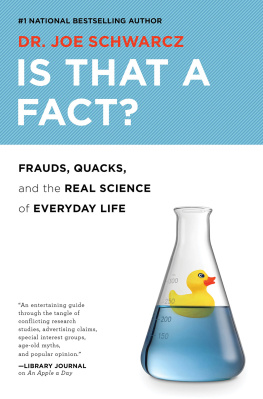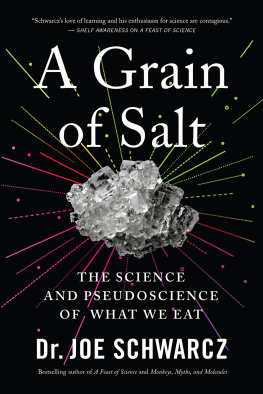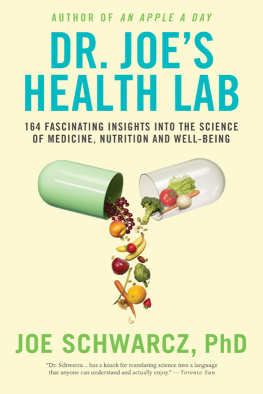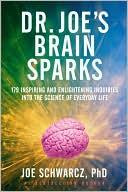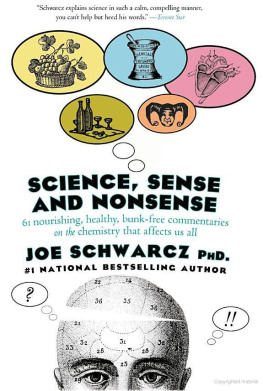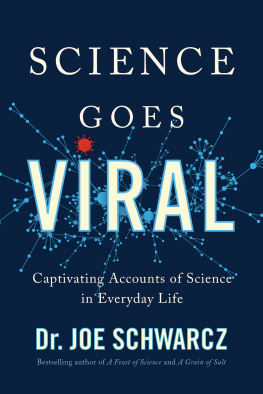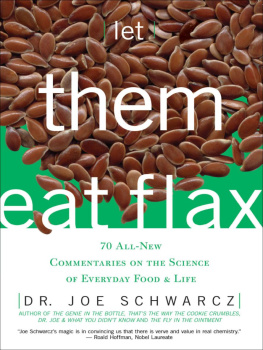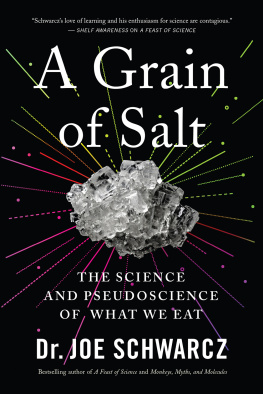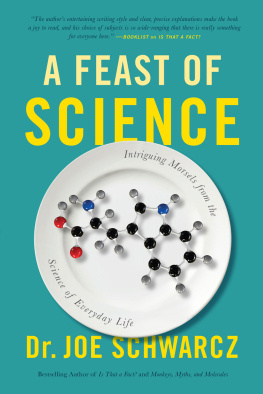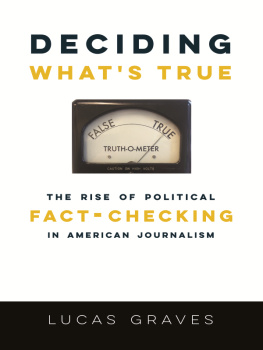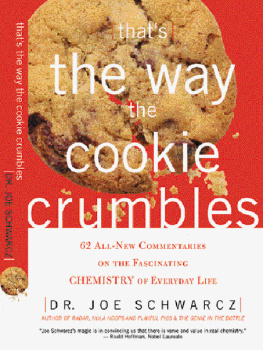Praise for The Fly in the Ointment
Joe Schwarcz has done it again. In fact, he has outdone it. This book is every bit as entertaining, informative, and authoritative as his previous celebrated collections, but contains enriched social fiber and ten percent more attitude per chapter. Whether hes assessing the legacy of Rachel Carson, coping with penile underachievement in alligators, or revealing the curdling secrets of cheese, Schwarcz never fails to fascinate.
Curt Supplee, former science editor, Washington Post
Wanna know how to wow em at a cocktail party or in a chemistry classroom? Take a stroll through the peripatetic journalistic world of the ideas and things of science brought to life by Dr. Joe. Here is narrative science at its best. The end result? In either place, scientific literacy made useful by The Fly in the Ointment.
Leonard Fine, professor of chemistry, Columbia University
Praise for Dr. Joe and What You Didnt Know
Any science writer can come up with the answers. But only Dr. Joe can turn the worlds most fascinating questions into a compelling journey through the great scientific mysteries of everyday life. Dr. Joe and What You Didnt Know proves yet again that all great science springs from the curiosity of asking the simple question and that Dr. Joe is one of the great science storytellers with both all the questions and answers.
Paul Lewis, president and general manager, Discovery Channel
Praise for Thats the Way the Cookie Crumbles
Schwarcz explains science in such a calm, compelling manner, you cant help but heed his words. How else to explain why Im now stir-frying cabbage for dinner and seeing its cruciferous cousins broccoli, cauliflower, and brussels sprouts in a delicious new light?
Cynthia David, Toronto Star
Praise for Radar, Hula Hoops, and Playful Pigs
It is hard to believe that anyone could be drawn to such a dull and smelly subject as chemistry until, that is, one picks up Joe Schwarczs book and is reminded that with every breath and feeling one is experiencing chemistry. Falling in love, we all know, is a matter of the right chemistry. Schwarcz gets his chemistry right, and hooks his readers.
John C. Polanyi, Nobel Laureate
Also by Dr. Joe Schwarcz
The Right Chemistry: 108 Enlightening, Nutritious, Health-Conscious, and Occasionally Bizarre Inquiries into the Science of Everyday Life
Dr. Joes Health Lab: 164 Amazing Insights into the Science of Medicine, Nutrition, and Well-Being
Dr. Joes Brain Sparks: 179 Inspiring and Enlightening Inquiries into the Science of Everyday Life
Science, Sense & Nonsense: 61 Nourishing, Healthy, Bunk-Free Commentaries on the Chemistry that Affects Us All
Brain Fuel: 199 Mind-Expanding Inquiries into the Science of Everyday Life
An Apple a Day: The Myths, Misconceptions and Truths About the Foods We Eat
Let Them Eat Flax: 70 All-New Commentaries on the Science of Everyday Food & Life
The Fly in the Ointment: 70 Fascinating Commentaries on the Science of Everyday Life
Dr. Joe and What You Didnt Know: 177 Fascinating Questions and Answers about the Chemistry of Everyday Life
Thats the Way the Cookie Crumbles: 62 All-New Commentaries on the Fascinating Chemistry of Everyday Life
The Genie in the Bottle: 64 All-New Commentaries on the Fascinating Chemistry of Everyday Life
Radar, Hula Hoops, and Playful Pigs: 67 Digestible Commentaries on the Fascinating Chemistry of Everyday Life
IS THAT A FACT?
Frauds, Quacks, and the Real Science of Everyday Life
Dr. Joe Schwarcz
ECW Press
IN THE BEGINNING
Is That a Fact?
Is that a fact? They say that I heard that Just listen in on a few conversations around the water cooler and it wont be long before one of these phrases rings out. After all, this is the Communication Age. We are connected through cell phones, radio, TV , and, of course, the web. We talk, we Tweet, we link, we text, we Facebook. We are informed. But in many cases, unfortunately, we are also misinformed.
We suffer from information overload. Just Google a subject and within a second, you can be flooded with a million references. It is therefore more important than ever to be able to analyze those references and know how to separate sense from nonsense. And thats where learning comes in. Information has to be scrutinized in the light of what is already known. But learning must be coupled with critical thinking. Confucius said it very well: Learning without thought is labor lost; thought without learning is perilous.
The University of Google is well stocked with information, but its students are left to flounder when it comes to determining whether that information is reliable. Accounts of miraculous cancer cures, the rants of anti-vaccine activists, the exploits of so-called psychics, and the claims of various alternative healers may sound very seductive, but stand to lose their luster in the light of scientific education. It would, however, be incorrect to suggest that education is the vaccine against folly. The annals of history are replete with examples of educated people who have succumbed to nonsense. Sir Arthur Conan Doyle, a physician by training, believed in fairies and in communicating with the dead. Curiously, he was the creator of Sherlock Holmes, who was a logician extraordinaire and eschewed such silliness.
Indeed, it was Holmes who reminded us, It is a capital mistake to theorize before one has data. Insensibly one begins to twist facts to suit theories instead of theories to suit facts. These days, those of us who follow Holmess dictum and put evidence-based science on a pedestal often get criticized for challenging claims we consider to be unscientific. They laughed at Galileo, the promoters of such claims say, and at Columbus, and at the Wright Brothers. But, as Carl Sagan pointed out, the fact that some geniuses were laughed at does not imply that all who are laughed at are geniuses. They also laughed at Bozo the Clown.
Our best bet in order to differentiate the Bozos from the prospective Galileos is to push for more science education at all levels, with a strong emphasis on the importance of critical thinking. Furthermore, it should be realized that when it comes to separating sense from nonsense, mental prowess is not enough. Benjamin Franklin was right on when he opined, Genius without education is like silver in a mine. Indeed, the value is there, but the silver is not of much use until you extract it. But how do you go about this extraction? How do we know who is right and who is wrong? How do we know what is a fact and what is not? How do I know what I claim to know? Actually, that is a question I had to contemplate recently when a student innocently asked me, And how do you know that?
I had just finished a lecture on toxicology in which I had described the problem of cyanide poisoning by cassava, a tuber similar to the potato that is a staple in some parts of Africa. However, with some varieties of cassava, theres an issue: if not properly processed, it can harbor a lethal amount of cyanide. (This is not the case with the cassava grown in the Caribbean.) But soaking the peeled tuber in water for several days releases enzymes that degrade the cyanide-storage compound linamarin, causing the toxic cyanide to be dissipated into the air as hydrogen cyanide. Unfortunately, cases of acute cyanide poisoning have occurred when famine conditions forced a shortening of the soaking time. Since even proper processing doesnt remove all the cyanide, chronic low-level exposure can lead to goiter or even konzo, a type of paralysis.

